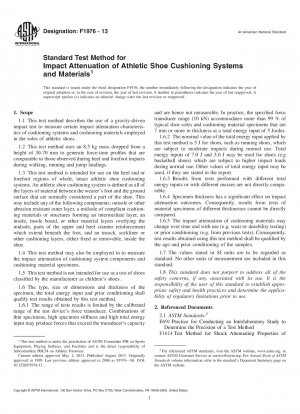ASTM F1976-13
Standard Test Method for Impact Attenuation of Athletic Shoe Cushioning Systems and Materials
- Standard No.
- ASTM F1976-13
- Release Date
- 2013
- Published By
- American Society for Testing and Materials (ASTM)
- Latest
- ASTM F1976-13
- Scope
5.1 This test method is used by athletic footwear manufacturers and others, both as a tool for development of athletic shoe cushioning systems and as a test of the general cushioning characteristics of athletic footwear products, materials and components. Adherence to the requirements and recommendations of this test method will provide repeatable results that can be compared among laboratories.
5.2 Data obtained by these procedures are indicative of the impact attenuation of athletic shoe cushioning systems under the specific conditions employed.
5.3 This test method is designed to provide data on the force versus displacement response of athletic footwear cushioning systems under essentially uniaxial impact loads at rates that are similar to those of heel and forefoot impacts during different athletic activities.
5.4 The peak or maximum values of force, acceleration, displacement, and strain are dependent on the total impact energy applied to the specimen. These values are normalized to provide comparative results for a reference value of total energy input.
5.5 Impact attenuation outcomes are strongly dependent on initial conditions (impact mass, impact velocity, contact area, etc.) and on specimen size and the specimen’s prior history of compressive loading. Therefore results should be compared only for specimens of the same nominal size and prior conditioning.
Note 1—Impact test outcomes have been found to correlate with in-vivo loads (peak ground reaction force, peak plantar pressure, lower extremity acceleration) experienced by runners. Relationships between test outcomes and subjective perceptions of cushioning have also been found. However, there is no direct evidence of a correlation between scores on this test method and the probability of injury among users of a particular athletic footwear product.1.1 This test method describes the use of a gravity-driven impact test to measure certain impact attenuation characteristics of cushioning systems and cushioning materials employed in the soles of athletic shoes.
1.2 This test method uses an 8.5 kg mass dropped from a height of 30-70 mm to generate force-time profiles that are comparable to those observed during heel and forefoot impacts during walking, running and jump landings.
1.3 This test method is intended for use on the heel and or forefoot regions of whole, intact athletic shoe cushioning systems. An athletic shoe cushioning system is defined as all of the layers of material between the wearer's foot and the ground surface that are normally considered a part of the shoe. This may include any of the following components: outsole or other abrasion resistant outer layer, a midsole of compliant cushioning materials or structures forming an intermediate layer, an insole, insole board, or other material layers overlying the midsole, parts of the upper and heel counter reinforcement which extend beneath the foot, and an insock, sockliner or other cushioning layers, either fixed or removable, inside the shoe.
1.4 This test method may also be employed in to measure the impact attenuation......
ASTM F1976-13 Referenced Document
- ASTM E691 Standard Practice for Conducting an Interlaboratory Study to Determine the Precision of a Test Method
- ASTM F1614 Standard Test Method for Shock Attenuating Properties of Materials Systems for Athletic Footwear
- ASTM F2650 Standard Terminology Relating to Impact Testing of Sports Surfaces and Equipment*, 2024-04-20 Update
ASTM F1976-13 history
- 2013 ASTM F1976-13 Standard Test Method for Impact Attenuation of Athletic Shoe Cushioning Systems and Materials
- 2006 ASTM F1976-06 Standard Test Method for Impact Attenuation Properties of Athletic Shoes Using an Impact Test
- 1999 ASTM F1976-99 Standard Test Method for Cushioning Properties of Athletic Shoes Using an Impact Test

Copyright ©2024 All Rights Reserved